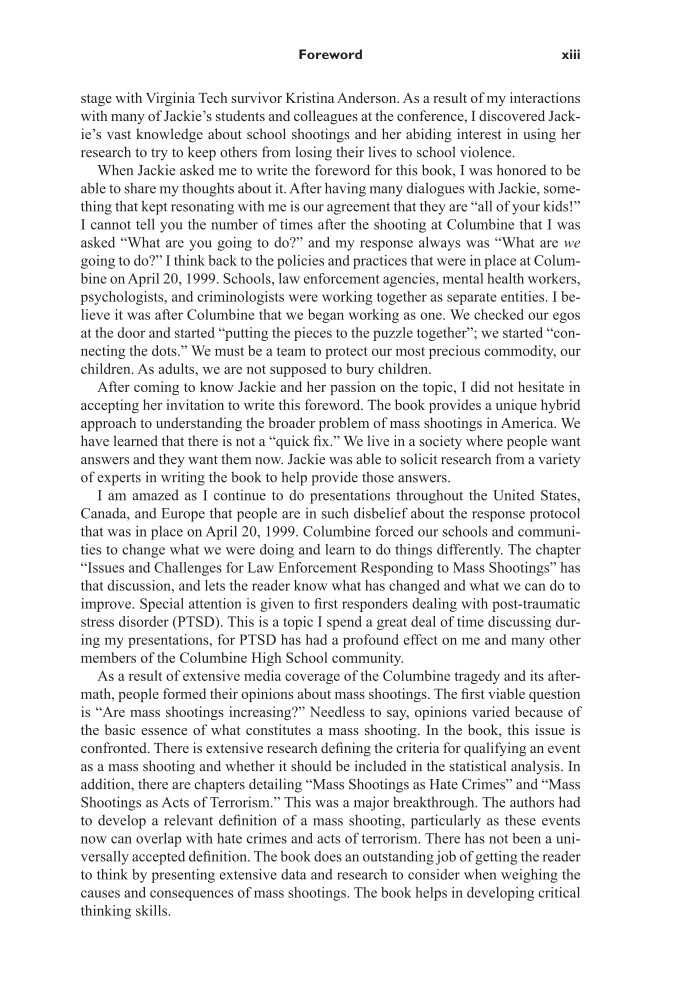Foreword xiii stage with Virginia Tech survivor Kristina Anderson. As a result of my interactions with many of Jackie’s students and colleagues at the conference, I discovered Jack- ie’s vast knowledge about school shootings and her abiding interest in using her research to try to keep others from losing their lives to school violence. When Jackie asked me to write the foreword for this book, I was honored to be able to share my thoughts about it. After having many dialogues with Jackie, some- thing that kept resonating with me is our agreement that they are “all of your kids!” I cannot tell you the number of times after the shooting at Columbine that I was asked “What are you going to do?” and my response always was “What are we going to do?” I think back to the policies and practices that were in place at Colum- bine on April 20, 1999. Schools, law enforcement agencies, mental health workers, psychologists, and criminologists were working together as separate entities. I be- lieve it was after Columbine that we began working as one. We checked our egos at the door and started “putting the pieces to the puzzle together” we started “con- necting the dots.” We must be a team to protect our most precious commodity, our children. As adults, we are not supposed to bury children. After coming to know Jackie and her passion on the topic, I did not hesitate in accepting her invitation to write this foreword. The book provides a unique hybrid approach to understanding the broader problem of mass shootings in America. We have learned that there is not a “quick fix.” We live in a society where people want answers and they want them now. Jackie was able to solicit research from a variety of experts in writing the book to help provide those answers. I am amazed as I continue to do presentations throughout the United States, Canada, and Europe that people are in such disbelief about the response protocol that was in place on April 20, 1999. Columbine forced our schools and communi- ties to change what we were doing and learn to do things differently. The chapter “Issues and Challenges for Law Enforcement Responding to Mass Shootings” has that discussion, and lets the reader know what has changed and what we can do to improve. Special attention is given to first responders dealing with post-traumatic stress disorder (PTSD). This is a topic I spend a great deal of time discussing dur- ing my presentations, for PTSD has had a profound effect on me and many other members of the Columbine High School community. As a result of extensive media coverage of the Columbine tragedy and its after- math, people formed their opinions about mass shootings. The first viable question is “Are mass shootings increasing?” Needless to say, opinions varied because of the basic essence of what constitutes a mass shooting. In the book, this issue is confronted. There is extensive research defining the criteria for qualifying an event as a mass shooting and whether it should be included in the statistical analysis. In addition, there are chapters detailing “Mass Shootings as Hate Crimes” and “Mass Shootings as Acts of Terrorism.” This was a major breakthrough. The authors had to develop a relevant definition of a mass shooting, particularly as these events now can overlap with hate crimes and acts of terrorism. There has not been a uni- versally accepted definition. The book does an outstanding job of getting the reader to think by presenting extensive data and research to consider when weighing the causes and consequences of mass shootings. The book helps in developing critical thinking skills.
Document Details My Account Print multiple pages
Print
You have printed 0 times in the last 24 hours.
Your print count will reset on at .
You may print 0 more time(s) before then.
You may print a maximum of 0 pages at a time.















































































































































































































































































































































































